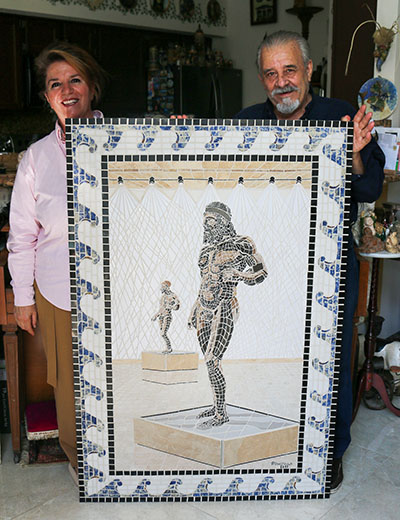Not every village can claim that it is home to a world-renowned Italian artist, but Wellington can.
Artist Tito Mangiola, who lent his skills to area high schools as a teacher, has spent the last 30-plus years with his wife, Leonarda, calling Wellington their home.
Just recently, Mangiola finished a 54-inch-by-36-inch mosaic project that pays homage to the “Bronzi di Riace” Greek sculptures found under the sea in Italy.
“I was born in the part of Calabria formerly called Magna Grecia,” Mangiola said. “I remember well the discovery of the bronzes in the sea of Riace.”
The bronze sculptures, discovered in 1972, are two bronze statues of bearded, naked warriors that are life size. They’re called the Riace warriors, the Riace bronzes or the Bronzi di Riace, and were found in the Mediterranean Sea by Stefano Mariottini.
The statues are dated to around 460 to 450 BCE, and are on display in Reggio Calabria, Italy, at the Museo Archeologico Nazionale Di Reggio Calabria, or the National Archeological Museum of Reggio Calabria.
The statues were created using a lost-wax technique, and last year marked the 50th anniversary of their discovery.
Mangiola wanted to create a mosaic to commemorate the discovery. He used stone, ceramic, porcelain, marble and travertine to make the unique mosaic, which weighs in at 50 pounds.
He searched for the right materials to give the project justice. The frame looks like waves as a nod to the statues being found under the sea.
Ancient Greek sculptures have always captivated Mangiola, especially with the methods of sculpting hair and beards. Those details were something that Mangiola took special care to add in his mosaic.
At the museum, one statue is in the foreground and the other in the background. This is replicated in Mangiola’s mosaic.
The mosaic took time, effort, research and dedication to put together.
“I have been using this mosaic technique for more than a year,” Mangiola said. “It gives me so much satisfaction, both in the decorative form and in the freedom of expression.”
Mangiola’s mosaic is expected to go on an exhibit tour before going to the National Archeological Museum of Reggio Calabria, its final destination, where it can be exhibited permanently with the sculptures.
For more info., and to learn more about Mangiola’s artwork, visit www.titomangiola.com.
Learn more about the museum, at www.museoarcheologicoreggiocalabria.it/?lang=en.








